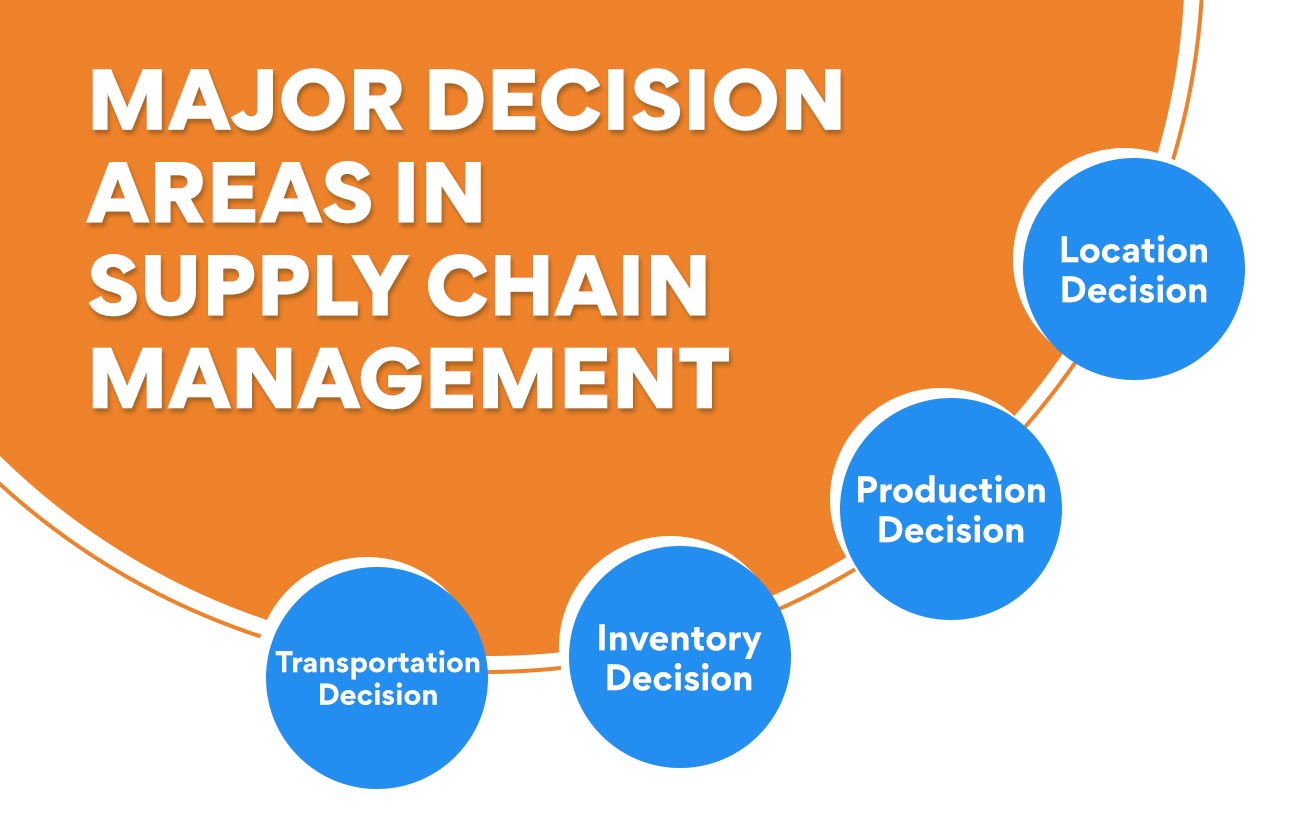The supply chain is a process that encompasses the steps it takes to get a product or service from its source to the customer. Supply chain management aims to ensure that the right products are delivered to the customers at the right time while maximising efficiency and costs. There are many aspects of supply chain management, and each one plays a critical role in getting products to customers. The major decision areas in supply chain management are 1) location, 2) production, 3) inventory, and 4) transportation (distribution).
This blog post will discuss the major decision areas in supply chain management, how they influence supply chain management, and explain them with examples.
What Is Supply Chain Management, and Why Does It Matter?
Supply chain management (SCM) is about planning, executing, and controlling the operations of the supply chain as a whole. It includes managing the movement and storage of raw materials, work-in-progress products, and finished goods from origin to consumption.
SCM also involves coordinating and integrating these activities with the activities of other departments within the organisation, such as accounting, finance, marketing, and manufacturing. In addition, SCM requires close cooperation and coordination with suppliers and outside service providers.
The goal of SCM is to optimise the overall performance of the supply chain by reducing costs and enhancing service levels and customer satisfaction. Many organisations view SCM as a strategic differentiator that can give them a competitive advantage in the marketplace.
What Is Supply Chain Strategy?
The goal of any supply chain strategy should be to create a plan that outlines how the company will get its products or services to market. The main objective is to minimise costs and optimise customer service levels. The decision made in the supply chain strategy should be aligned with future business goals. The strategic plan will also take into account any company’s competitive advantages.
Key Elements of supply chain strategy
There are plenty of supply chain strategies, but most can be boiled down to a few key elements.

Supply chains are expensive, and the goal of any good strategy is to minimise costs while still delivering the desired level of service. This often means finding ways to streamline the supply chain or using cheaper materials or labour.
Delivery time
Customers always want their orders to arrive on time, so reducing delivery time is a significant goal of supply chain management. This might involve improving communication between suppliers and customers or increasing the efficiency of the manufacturing process.
Quality
Of course, customers also expect their products to be high quality, so maintaining a good level of quality control is essential. This might mean investing in better-quality materials or more rigorous testing at different points in the supply chain.
Flexibility
In today’s fast-paced world, businesses must respond quickly to changes in customer demand. This means having a supply chain that is flexible enough to make changes as required. This might involve stocking a more comprehensive range of products or using just-in-time manufacturing to produce items only as they are needed.
Sustainability
More and more businesses are also looking for ways to make their supply chains more sustainable for environmental reasons and to improve their reputation with customers. This might mean using recycled materials, investing in renewable energy, or finding ways to reduce waste throughout the supply chain.
Reachability
The goal of any business is to reach as many potential customers as possible. But in order for that to happen, the supply chain needs to be able to deliver products to them. This might mean expanding into new markets or setting up distribution centres strategically.
Customer Satisfaction
At the end of the day, the goal of any supply chain is to keep customers happy. This might mean ensuring that products are delivered on time, providing good customer service, or offering a wide range of products.
As you can see, many factors are needed to consider when developing a supply chain strategy. The ideal approach to creating a successful strategy is to work with an experienced supply chain management consultant who can help you identify your specific goals and find the best way to achieve them.
Want to discover more about supply chain management and start a career? Take a look at our Advanced Certificate in Ops, SCM, and PM, which gives you a detailed insight into supply chain management.
Major Decision Areas in Supply Chain Management
The decision areas in supply chain management basically involve making decisions about the entire process of moving goods from the supplier to the customer. The main goal is to minimise costs and optimise resources while ensuring timely delivery.

Location Decision
The first and foremost decision in supply chain management is deciding on the location of manufacturing plants, warehouses, and distribution centres. Various factors influence this decision, such as customer demand, supplier locations, transportation costs, etc. The main objective is to minimise the overall cost of transportation while ensuring timely delivery.
With a proper determination regarding the locations of the manufacturing plants, warehouses, and distribution centres, it would be possible to develop an optimised route for the transportation of goods. This would further help reduce the overall cost and the time required for delivery.
How does Location Decision Impacts Supply Chain Management?
The location decision directly impacts supply chain management as it helps in minimising the overall cost and time required for transportation. In addition to this, proper location planning also helps in reducing the number of inventory levels, which is another crucial factor in supply chain management.
It helps supply managers to keep track of the movement of goods and also helps in reducing the cost of inventory. Location decision often makes it seamless for the distribution of goods and helps achieve customer satisfaction. It is imperative to realise that customer satisfaction is one of the most important goals of supply chain management.
Checking the availability of resources is yet another important factor that must be considered. The manufacturing plants, warehouses, and distribution centres should be located in such a way that they have easy access to raw materials, labour, and other resources. This would help reduce the overall cost and the time required for production and delivery.
Production Decision
A production decision is a crucial decision in the supply chain as it determines the production process, quantity, and quality of products. The objective of this decision is to minimise the cost while meeting customer’s demand. In order to make an effective production decision, the company needs to consider various factors such as type of product, demand forecast, manufacturing process, capacity utilisation, and inventory level.
The first stage of production decision is forecasting. A company needs to forecast the demand for its products or services to produce the right quantity. Sales and marketing are vital in providing input for this decision.
The second stage is capacity planning. A company should check whether they have enough capacity to meet the forecasted demand. It also needs to consider the lead time required to produce the product.
The third stage is inventory planning. To meet customer demand, a company must determine how much inventory to keep on hand. It also needs to consider the cost of holding inventory, such as storage and opportunity costs.
After considering all these factors, a company can decide on the type of production process, quantity, and quality of products. A production decision is complex, requiring a lot of experience and knowledge to make an effective decision.
How does Production Decision Helps Supply Chain Management?
The production decision is one of the most important decisions that a company has to make. It directly affects the cost, quality, and delivery of the product. A company has to decide how much to produce, when, and where to produce it.
The production decision is a complex one, and it is directly linked to the other two major decision areas in supply chain management, i.e., inventory decisions and capacity decisions. All three of these decisions are interrelated, and a change in one decision area can impact the other two.
Inventory decisions involve deciding how much inventory to keep on hand and where to store it. Capacity decisions include deciding how much capacity is needed and when to add or expand capacity.
The production decision is also linked to the marketing decisions. The marketing decisions involve deciding what products to produce and how to price them. The production decision must consider the product’s demand and the company’s ability to produce the product.
Inventory Decision
Inventory decision is another important aspect of supply chain management. It basically involves deciding the right inventory level that must be maintained at all times. Customer demand, lead time, production rate, etc. ., are the various factors that must be taken into consideration. The main goal is to minimise the cost of inventory while ensuring timely delivery.
Inventory decision has a direct impact on supply chain management as it helps in minimising the overall cost of inventory. In addition, proper inventory planning also helps reduce the number of stockouts, which is another important factor in supply chain management.
The absence of an adequate inventory decision-making process often leads to stockouts, resulting in loss of sales and customer satisfaction. It is essential to have a proper inventory decision-making process in place to avoid such a situation. This would help reduce the overall cost and time required for production and delivery.
How does Inventory Decision Benefits Supply Chain Management?
Inventory decision is one of the most critical areas of supply chain management. By keeping an accurate inventory, businesses can ensure that they have the right products in stock to meet customer demand. It can help improve customer satisfaction levels and reduce costs associated with stockouts. An effective inventory management system can also help businesses avoid overstocking, which can tie up valuable capital.
There are several different inventory management strategies that businesses can use, and the most appropriate approach will vary depending on the organisation’s specific needs. Some common inventory management strategies include just-in-time (JIT) inventory, economic order quantity (EOQ), and inventory turnover.
When used effectively, inventory management can be a powerful tool for improving the overall efficiency of the supply chain. By taking the time to understand the different decision areas within supply chain management, businesses can develop strategies better suited to their specific needs and goals.
Transportation Decision
There are several types of transportation decisions that a company must make in order to optimise its supply chain.
The first is mode selection, which involves deciding what type of transportation to use (e.g. air, land, or water). The second is routing, which involves choosing the specific route the goods will take. The third is scheduling, which consists in deciding when the goods will be transported. And finally, there is capacity planning, which involves ensuring enough capacity to meet the company’s transportation needs.
Each of these decisions must be made in order to optimise the supply chain and minimise costs. For example, if company A is shipping its goods from India to China, it must first decide what mode of transportation to use. If they choose air transport, they will need to consider the specific route the goods will take and the transportation schedule. They will also need to ensure enough plane capacity to accommodate the shipment.
Making these decisions can be complex, but it is essential to consider all factors to optimise the supply chain and minimise costs. By understanding the major decision areas in supply chain management, companies can make better decisions and improve their overall efficiency.
How Transportation Decision Aids Supply Chain Management?
Transportation decision aids supply chain management by providing the necessary data to make informed decisions about shipping routes, carriers, and modes. This information can help to optimise the supply chain and reduce costs.
Several types of transportation decision support are available, including software programs, consultants, and online resources. The right aid will depend on the specific needs of the company and the supply chain.
Software programs provide detailed information about shipping routes, carrier options, and costs. They can also help to plan and track shipments. Consultants can also provide expert advice on transportation issues, including how to optimise the supply chain.
The Bottom Line
Supply chain management is a foundational stone to the success of any business. By understanding the different decision areas within supply chain management, companies can develop strategies to optimise their supply chains and improve their overall performance.
Starting a career in supply chain management can prove to be fruitful right now. We can help you get a head start with our Advanced Certificate in Ops, SCM, and PM wherein you can learn everything about SCM and more.


























